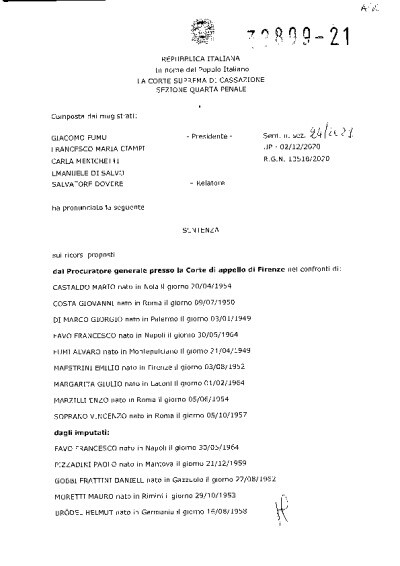
Date
Geographical Area
Europe
Countries
Italy
Keywords
Case Name
Andronico et al v Prosecutor
Case Reference
[2021] Sez. IV, n.32899, 8 January 2021, published on 6 September 2021 (Cassazione Penale)
Name of Court
Supreme Court of Cassation, Rome, Italy (Corte Suprema di Cassazione, Roma, Italia)
Key Facts
The “Viareggio disaster” was caused by the derailment of a freight train and subsequent fire which occurred on 29 June 2009 in a railway station in Viareggio, Lucca, a city in central Italy’s Tuscany region. Four carriages derailed and crashed into houses alongside the railway line. All of the carriages carried Liquefied Petroleum Gas (LPG). The LPG contained in the first carriage leaked as a consequence of the incident and exploded a few minutes later. Thirty-two people were killed and a further twenty-six were injured.
In 2017, the Lucca Trial Chamber tried thirty-three people. Ten defendants were acquitted and the others were convicted, including the former CEOs of the Italian National Railway (Rete Ferroviaria Italiana, RFI) and the representatives of the companies responsible for the mechanical problems that caused the accident, namely Gatx Rail Germany, Gatx Rail Austria, Jungenthal and others.
In 2019 the Court of Appeal of Florence partially confirmed the decision. In December 2020, the Supreme Court ruled on an appeal of the Court of Appeal decision.
In 2017, the Lucca Trial Chamber tried thirty-three people. Ten defendants were acquitted and the others were convicted, including the former CEOs of the Italian National Railway (Rete Ferroviaria Italiana, RFI) and the representatives of the companies responsible for the mechanical problems that caused the accident, namely Gatx Rail Germany, Gatx Rail Austria, Jungenthal and others.
In 2019 the Court of Appeal of Florence partially confirmed the decision. In December 2020, the Supreme Court ruled on an appeal of the Court of Appeal decision.
Decision and Reasoning
The Supreme Court ruled that the disaster would have been preventable with proper maintenance and so confirmed the convictions for the crime of culpable railway disaster for eleven of the defendants. Nine of those convicted were responsible for maintenance activities when the accident occurred and were employed by the companies. The court acquitted the rest of the defendants.
Additionally, the Supreme Court reviewed the existence of aggravating circumstances referred to in article 589(2) of the Italian Criminal Code, which foresees increased penalties “if the offense is committed in violation of the rules for the prevention of accidents at work.” In this respect, the Court found that the above provision did not apply in the instant case, as the damage caused did not fall within its scope of application and the breaches of the rules for the prevention of accidents at work did not in fact play a causal role in the occurrence of the events. This, in turn, meant that some of the offences allegedly committed were subject to a statute of limitations and could not be prosecuted.
Additionally, the Supreme Court reviewed the existence of aggravating circumstances referred to in article 589(2) of the Italian Criminal Code, which foresees increased penalties “if the offense is committed in violation of the rules for the prevention of accidents at work.” In this respect, the Court found that the above provision did not apply in the instant case, as the damage caused did not fall within its scope of application and the breaches of the rules for the prevention of accidents at work did not in fact play a causal role in the occurrence of the events. This, in turn, meant that some of the offences allegedly committed were subject to a statute of limitations and could not be prosecuted.
Outcome
The Supreme Court of Cassation confirmed the convictions for culpable railway disaster for eleven defendants, and declared the extinction of the criminal liability of manslaughter due to the statute of limitations.
Disclaimer
This case law summary was developed as part of the Disaster Law Database (DISLAW) project, and is not an official record of the case.
Document
Document